Investigating the Impact of Social Determinants on Depression in Women
VerifiedAdded on 2023/06/12
|14
|3824
|184
Essay
AI Summary
This essay examines the multifaceted issue of depression in women, focusing on the significant impact of social determinants such as family life, social interactions, work environment, and overall health. It highlights how depression can lead to isolation, communication difficulties, and decreased performance, affecting both personal and professional aspects of a woman's life. The essay further investigates specific social determinants, including gender inequality, unemployment, poor housing, inadequate maternal care, educational pressures, poverty, food insecurity, debt, early childhood experiences, and unstable neighborhood environments. It identifies potential stakeholders like the Canadian Immigration Citizenship, community-wide campaigns, and initiatives for better housing, emphasizing the need for comprehensive strategies to address these social factors and improve the mental health and well-being of women suffering from depression.
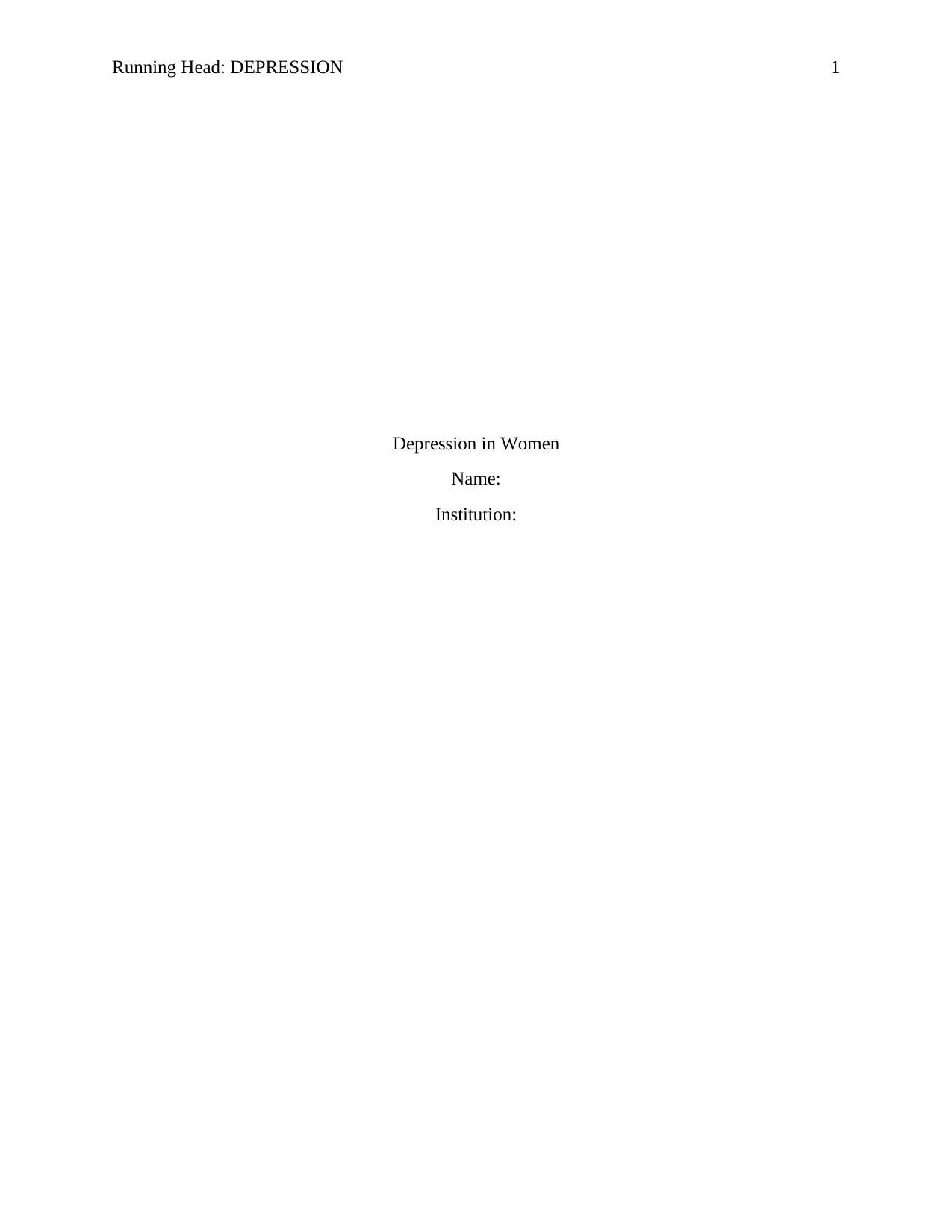
Running Head: DEPRESSION 1
Depression in Women
Name:
Institution:
Depression in Women
Name:
Institution:
Paraphrase This Document
Need a fresh take? Get an instant paraphrase of this document with our AI Paraphraser
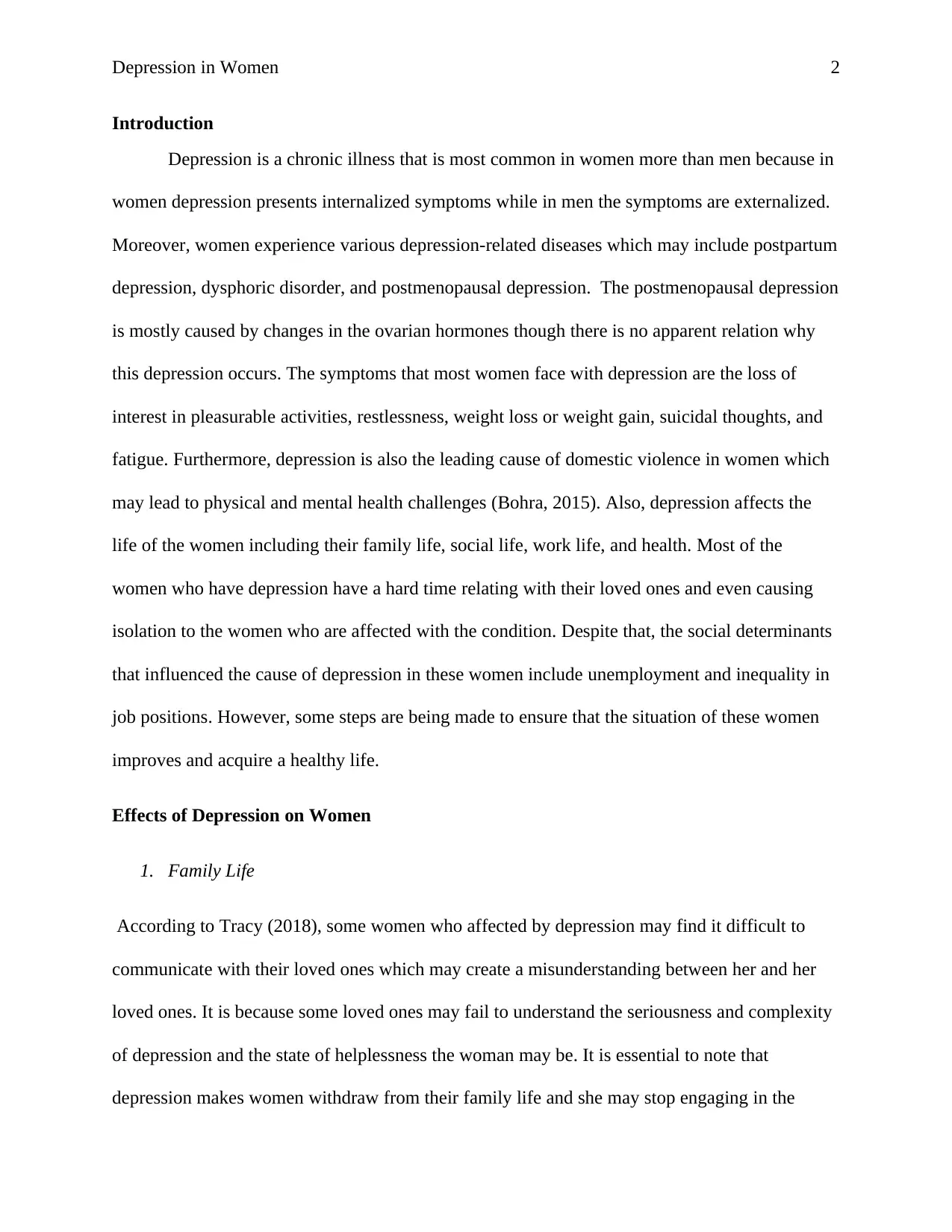
Depression in Women 2
Introduction
Depression is a chronic illness that is most common in women more than men because in
women depression presents internalized symptoms while in men the symptoms are externalized.
Moreover, women experience various depression-related diseases which may include postpartum
depression, dysphoric disorder, and postmenopausal depression. The postmenopausal depression
is mostly caused by changes in the ovarian hormones though there is no apparent relation why
this depression occurs. The symptoms that most women face with depression are the loss of
interest in pleasurable activities, restlessness, weight loss or weight gain, suicidal thoughts, and
fatigue. Furthermore, depression is also the leading cause of domestic violence in women which
may lead to physical and mental health challenges (Bohra, 2015). Also, depression affects the
life of the women including their family life, social life, work life, and health. Most of the
women who have depression have a hard time relating with their loved ones and even causing
isolation to the women who are affected with the condition. Despite that, the social determinants
that influenced the cause of depression in these women include unemployment and inequality in
job positions. However, some steps are being made to ensure that the situation of these women
improves and acquire a healthy life.
Effects of Depression on Women
1. Family Life
According to Tracy (2018), some women who affected by depression may find it difficult to
communicate with their loved ones which may create a misunderstanding between her and her
loved ones. It is because some loved ones may fail to understand the seriousness and complexity
of depression and the state of helplessness the woman may be. It is essential to note that
depression makes women withdraw from their family life and she may stop engaging in the
Introduction
Depression is a chronic illness that is most common in women more than men because in
women depression presents internalized symptoms while in men the symptoms are externalized.
Moreover, women experience various depression-related diseases which may include postpartum
depression, dysphoric disorder, and postmenopausal depression. The postmenopausal depression
is mostly caused by changes in the ovarian hormones though there is no apparent relation why
this depression occurs. The symptoms that most women face with depression are the loss of
interest in pleasurable activities, restlessness, weight loss or weight gain, suicidal thoughts, and
fatigue. Furthermore, depression is also the leading cause of domestic violence in women which
may lead to physical and mental health challenges (Bohra, 2015). Also, depression affects the
life of the women including their family life, social life, work life, and health. Most of the
women who have depression have a hard time relating with their loved ones and even causing
isolation to the women who are affected with the condition. Despite that, the social determinants
that influenced the cause of depression in these women include unemployment and inequality in
job positions. However, some steps are being made to ensure that the situation of these women
improves and acquire a healthy life.
Effects of Depression on Women
1. Family Life
According to Tracy (2018), some women who affected by depression may find it difficult to
communicate with their loved ones which may create a misunderstanding between her and her
loved ones. It is because some loved ones may fail to understand the seriousness and complexity
of depression and the state of helplessness the woman may be. It is essential to note that
depression makes women withdraw from their family life and she may stop engaging in the
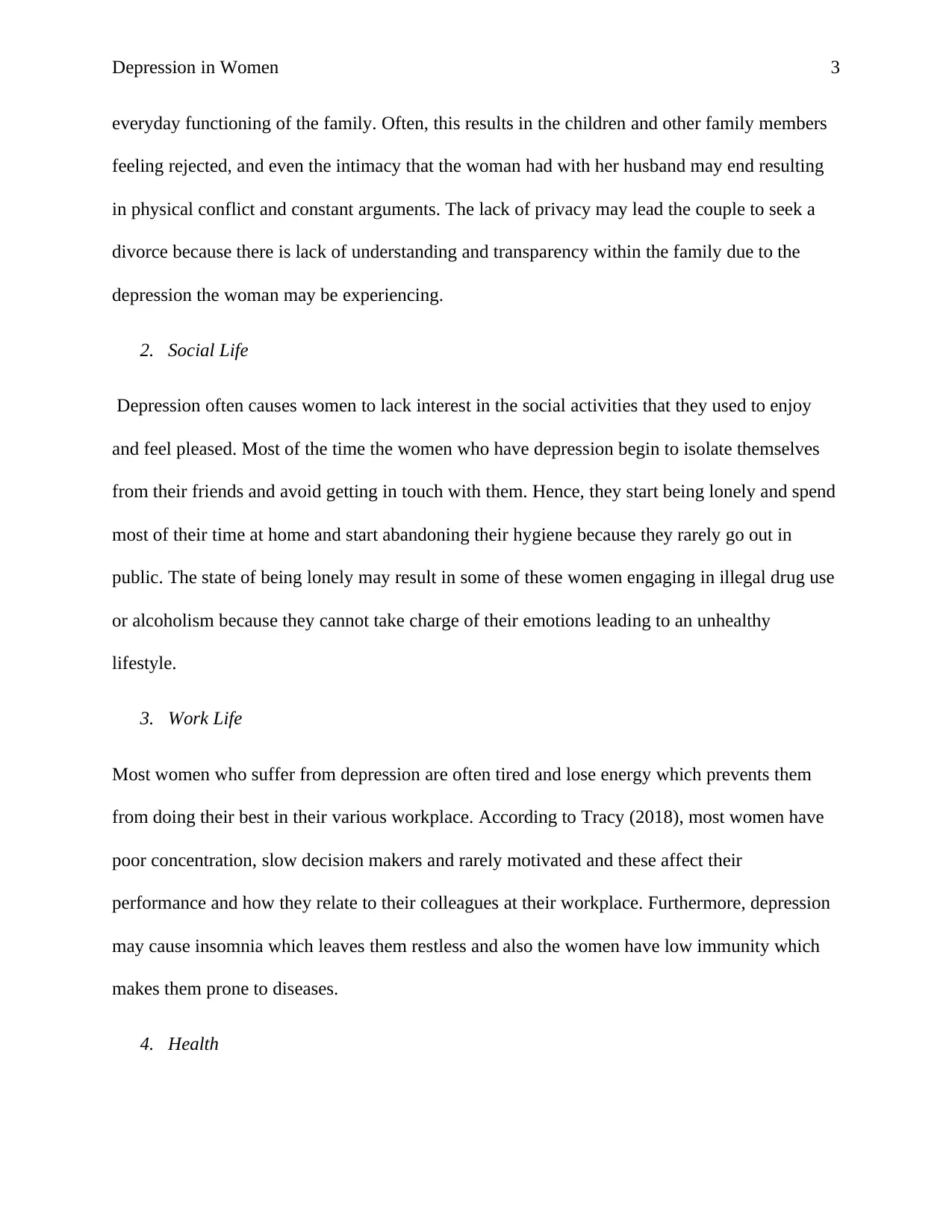
Depression in Women 3
everyday functioning of the family. Often, this results in the children and other family members
feeling rejected, and even the intimacy that the woman had with her husband may end resulting
in physical conflict and constant arguments. The lack of privacy may lead the couple to seek a
divorce because there is lack of understanding and transparency within the family due to the
depression the woman may be experiencing.
2. Social Life
Depression often causes women to lack interest in the social activities that they used to enjoy
and feel pleased. Most of the time the women who have depression begin to isolate themselves
from their friends and avoid getting in touch with them. Hence, they start being lonely and spend
most of their time at home and start abandoning their hygiene because they rarely go out in
public. The state of being lonely may result in some of these women engaging in illegal drug use
or alcoholism because they cannot take charge of their emotions leading to an unhealthy
lifestyle.
3. Work Life
Most women who suffer from depression are often tired and lose energy which prevents them
from doing their best in their various workplace. According to Tracy (2018), most women have
poor concentration, slow decision makers and rarely motivated and these affect their
performance and how they relate to their colleagues at their workplace. Furthermore, depression
may cause insomnia which leaves them restless and also the women have low immunity which
makes them prone to diseases.
4. Health
everyday functioning of the family. Often, this results in the children and other family members
feeling rejected, and even the intimacy that the woman had with her husband may end resulting
in physical conflict and constant arguments. The lack of privacy may lead the couple to seek a
divorce because there is lack of understanding and transparency within the family due to the
depression the woman may be experiencing.
2. Social Life
Depression often causes women to lack interest in the social activities that they used to enjoy
and feel pleased. Most of the time the women who have depression begin to isolate themselves
from their friends and avoid getting in touch with them. Hence, they start being lonely and spend
most of their time at home and start abandoning their hygiene because they rarely go out in
public. The state of being lonely may result in some of these women engaging in illegal drug use
or alcoholism because they cannot take charge of their emotions leading to an unhealthy
lifestyle.
3. Work Life
Most women who suffer from depression are often tired and lose energy which prevents them
from doing their best in their various workplace. According to Tracy (2018), most women have
poor concentration, slow decision makers and rarely motivated and these affect their
performance and how they relate to their colleagues at their workplace. Furthermore, depression
may cause insomnia which leaves them restless and also the women have low immunity which
makes them prone to diseases.
4. Health
⊘ This is a preview!⊘
Do you want full access?
Subscribe today to unlock all pages.

Trusted by 1+ million students worldwide
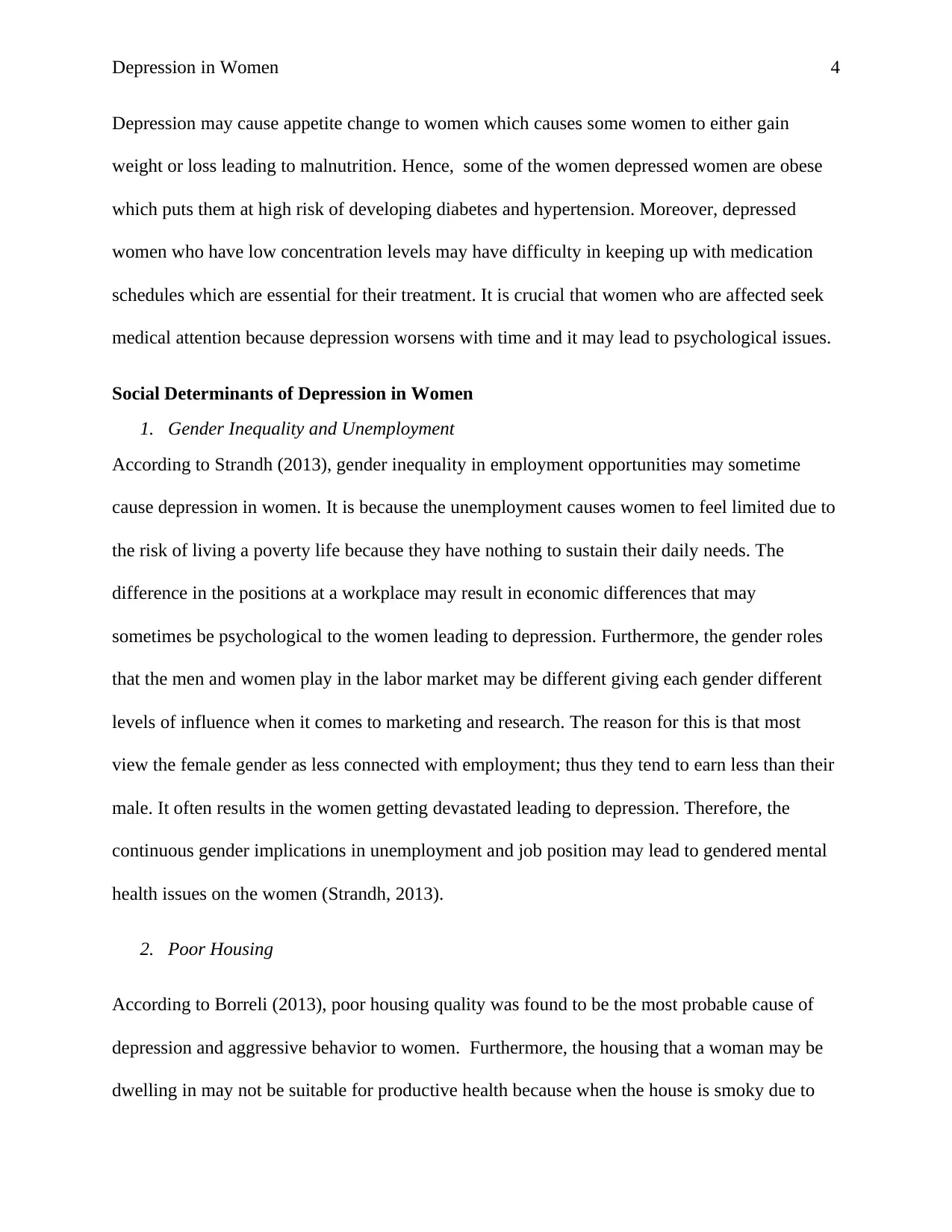
Depression in Women 4
Depression may cause appetite change to women which causes some women to either gain
weight or loss leading to malnutrition. Hence, some of the women depressed women are obese
which puts them at high risk of developing diabetes and hypertension. Moreover, depressed
women who have low concentration levels may have difficulty in keeping up with medication
schedules which are essential for their treatment. It is crucial that women who are affected seek
medical attention because depression worsens with time and it may lead to psychological issues.
Social Determinants of Depression in Women
1. Gender Inequality and Unemployment
According to Strandh (2013), gender inequality in employment opportunities may sometime
cause depression in women. It is because the unemployment causes women to feel limited due to
the risk of living a poverty life because they have nothing to sustain their daily needs. The
difference in the positions at a workplace may result in economic differences that may
sometimes be psychological to the women leading to depression. Furthermore, the gender roles
that the men and women play in the labor market may be different giving each gender different
levels of influence when it comes to marketing and research. The reason for this is that most
view the female gender as less connected with employment; thus they tend to earn less than their
male. It often results in the women getting devastated leading to depression. Therefore, the
continuous gender implications in unemployment and job position may lead to gendered mental
health issues on the women (Strandh, 2013).
2. Poor Housing
According to Borreli (2013), poor housing quality was found to be the most probable cause of
depression and aggressive behavior to women. Furthermore, the housing that a woman may be
dwelling in may not be suitable for productive health because when the house is smoky due to
Depression may cause appetite change to women which causes some women to either gain
weight or loss leading to malnutrition. Hence, some of the women depressed women are obese
which puts them at high risk of developing diabetes and hypertension. Moreover, depressed
women who have low concentration levels may have difficulty in keeping up with medication
schedules which are essential for their treatment. It is crucial that women who are affected seek
medical attention because depression worsens with time and it may lead to psychological issues.
Social Determinants of Depression in Women
1. Gender Inequality and Unemployment
According to Strandh (2013), gender inequality in employment opportunities may sometime
cause depression in women. It is because the unemployment causes women to feel limited due to
the risk of living a poverty life because they have nothing to sustain their daily needs. The
difference in the positions at a workplace may result in economic differences that may
sometimes be psychological to the women leading to depression. Furthermore, the gender roles
that the men and women play in the labor market may be different giving each gender different
levels of influence when it comes to marketing and research. The reason for this is that most
view the female gender as less connected with employment; thus they tend to earn less than their
male. It often results in the women getting devastated leading to depression. Therefore, the
continuous gender implications in unemployment and job position may lead to gendered mental
health issues on the women (Strandh, 2013).
2. Poor Housing
According to Borreli (2013), poor housing quality was found to be the most probable cause of
depression and aggressive behavior to women. Furthermore, the housing that a woman may be
dwelling in may not be suitable for productive health because when the house is smoky due to
Paraphrase This Document
Need a fresh take? Get an instant paraphrase of this document with our AI Paraphraser
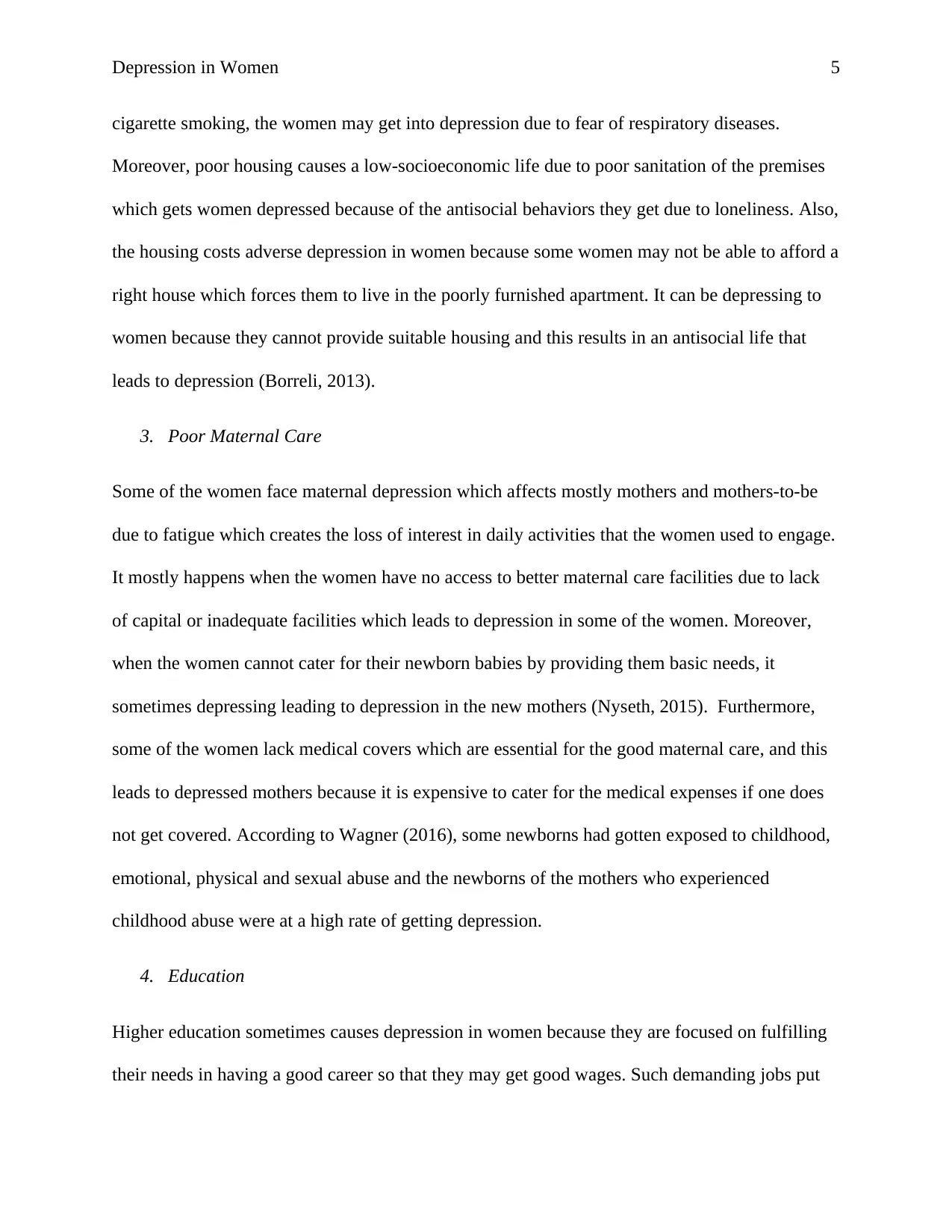
Depression in Women 5
cigarette smoking, the women may get into depression due to fear of respiratory diseases.
Moreover, poor housing causes a low-socioeconomic life due to poor sanitation of the premises
which gets women depressed because of the antisocial behaviors they get due to loneliness. Also,
the housing costs adverse depression in women because some women may not be able to afford a
right house which forces them to live in the poorly furnished apartment. It can be depressing to
women because they cannot provide suitable housing and this results in an antisocial life that
leads to depression (Borreli, 2013).
3. Poor Maternal Care
Some of the women face maternal depression which affects mostly mothers and mothers-to-be
due to fatigue which creates the loss of interest in daily activities that the women used to engage.
It mostly happens when the women have no access to better maternal care facilities due to lack
of capital or inadequate facilities which leads to depression in some of the women. Moreover,
when the women cannot cater for their newborn babies by providing them basic needs, it
sometimes depressing leading to depression in the new mothers (Nyseth, 2015). Furthermore,
some of the women lack medical covers which are essential for the good maternal care, and this
leads to depressed mothers because it is expensive to cater for the medical expenses if one does
not get covered. According to Wagner (2016), some newborns had gotten exposed to childhood,
emotional, physical and sexual abuse and the newborns of the mothers who experienced
childhood abuse were at a high rate of getting depression.
4. Education
Higher education sometimes causes depression in women because they are focused on fulfilling
their needs in having a good career so that they may get good wages. Such demanding jobs put
cigarette smoking, the women may get into depression due to fear of respiratory diseases.
Moreover, poor housing causes a low-socioeconomic life due to poor sanitation of the premises
which gets women depressed because of the antisocial behaviors they get due to loneliness. Also,
the housing costs adverse depression in women because some women may not be able to afford a
right house which forces them to live in the poorly furnished apartment. It can be depressing to
women because they cannot provide suitable housing and this results in an antisocial life that
leads to depression (Borreli, 2013).
3. Poor Maternal Care
Some of the women face maternal depression which affects mostly mothers and mothers-to-be
due to fatigue which creates the loss of interest in daily activities that the women used to engage.
It mostly happens when the women have no access to better maternal care facilities due to lack
of capital or inadequate facilities which leads to depression in some of the women. Moreover,
when the women cannot cater for their newborn babies by providing them basic needs, it
sometimes depressing leading to depression in the new mothers (Nyseth, 2015). Furthermore,
some of the women lack medical covers which are essential for the good maternal care, and this
leads to depressed mothers because it is expensive to cater for the medical expenses if one does
not get covered. According to Wagner (2016), some newborns had gotten exposed to childhood,
emotional, physical and sexual abuse and the newborns of the mothers who experienced
childhood abuse were at a high rate of getting depression.
4. Education
Higher education sometimes causes depression in women because they are focused on fulfilling
their needs in having a good career so that they may get good wages. Such demanding jobs put
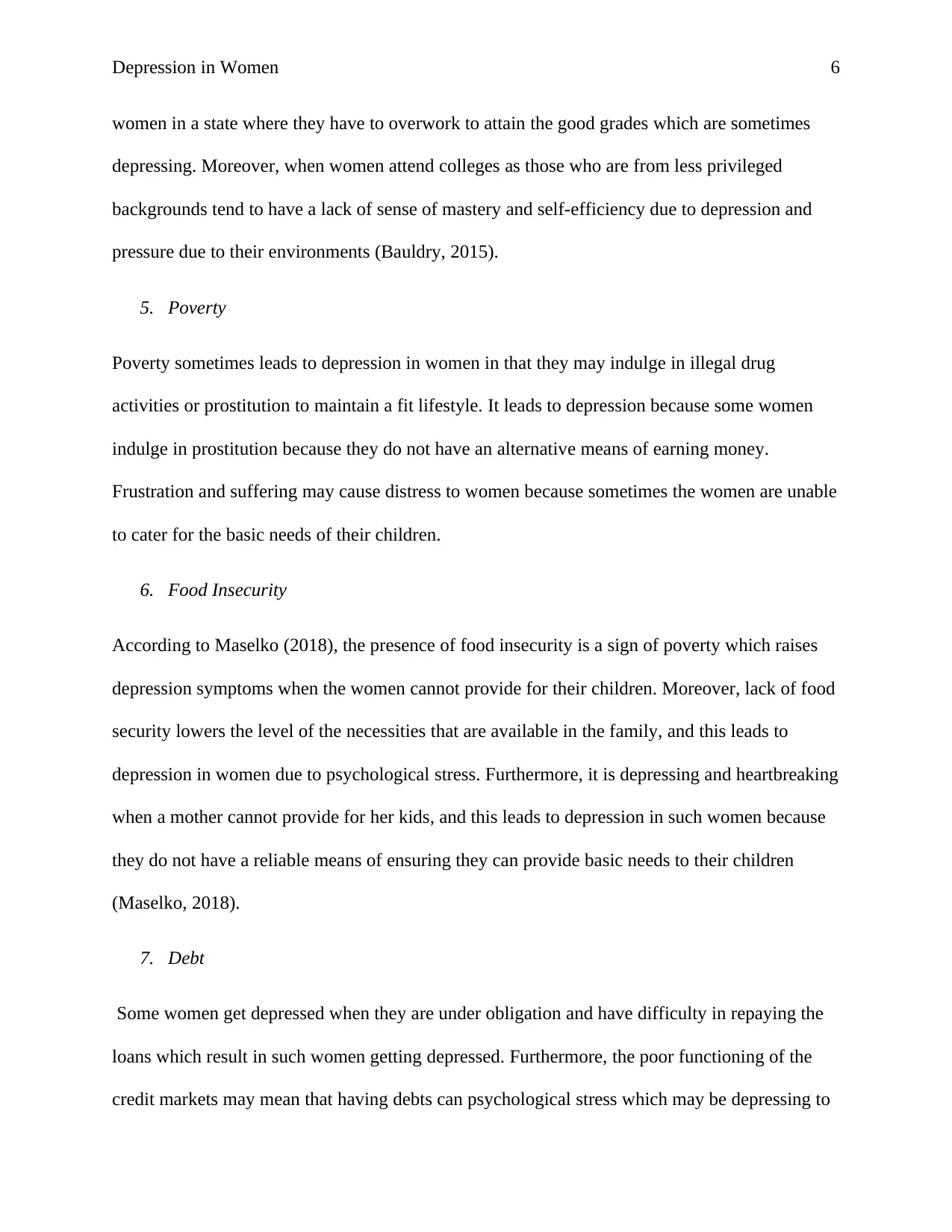
Depression in Women 6
women in a state where they have to overwork to attain the good grades which are sometimes
depressing. Moreover, when women attend colleges as those who are from less privileged
backgrounds tend to have a lack of sense of mastery and self-efficiency due to depression and
pressure due to their environments (Bauldry, 2015).
5. Poverty
Poverty sometimes leads to depression in women in that they may indulge in illegal drug
activities or prostitution to maintain a fit lifestyle. It leads to depression because some women
indulge in prostitution because they do not have an alternative means of earning money.
Frustration and suffering may cause distress to women because sometimes the women are unable
to cater for the basic needs of their children.
6. Food Insecurity
According to Maselko (2018), the presence of food insecurity is a sign of poverty which raises
depression symptoms when the women cannot provide for their children. Moreover, lack of food
security lowers the level of the necessities that are available in the family, and this leads to
depression in women due to psychological stress. Furthermore, it is depressing and heartbreaking
when a mother cannot provide for her kids, and this leads to depression in such women because
they do not have a reliable means of ensuring they can provide basic needs to their children
(Maselko, 2018).
7. Debt
Some women get depressed when they are under obligation and have difficulty in repaying the
loans which result in such women getting depressed. Furthermore, the poor functioning of the
credit markets may mean that having debts can psychological stress which may be depressing to
women in a state where they have to overwork to attain the good grades which are sometimes
depressing. Moreover, when women attend colleges as those who are from less privileged
backgrounds tend to have a lack of sense of mastery and self-efficiency due to depression and
pressure due to their environments (Bauldry, 2015).
5. Poverty
Poverty sometimes leads to depression in women in that they may indulge in illegal drug
activities or prostitution to maintain a fit lifestyle. It leads to depression because some women
indulge in prostitution because they do not have an alternative means of earning money.
Frustration and suffering may cause distress to women because sometimes the women are unable
to cater for the basic needs of their children.
6. Food Insecurity
According to Maselko (2018), the presence of food insecurity is a sign of poverty which raises
depression symptoms when the women cannot provide for their children. Moreover, lack of food
security lowers the level of the necessities that are available in the family, and this leads to
depression in women due to psychological stress. Furthermore, it is depressing and heartbreaking
when a mother cannot provide for her kids, and this leads to depression in such women because
they do not have a reliable means of ensuring they can provide basic needs to their children
(Maselko, 2018).
7. Debt
Some women get depressed when they are under obligation and have difficulty in repaying the
loans which result in such women getting depressed. Furthermore, the poor functioning of the
credit markets may mean that having debts can psychological stress which may be depressing to
⊘ This is a preview!⊘
Do you want full access?
Subscribe today to unlock all pages.

Trusted by 1+ million students worldwide
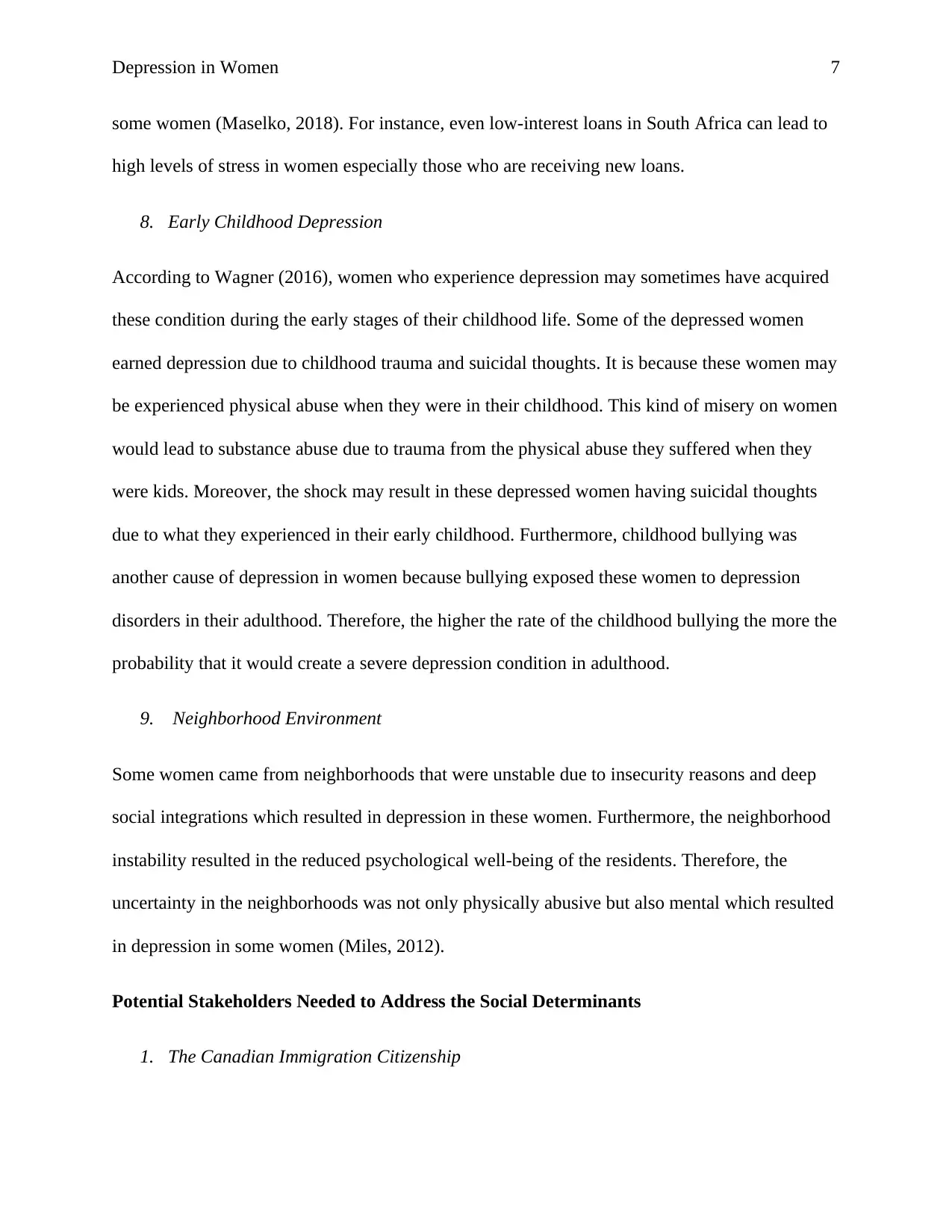
Depression in Women 7
some women (Maselko, 2018). For instance, even low-interest loans in South Africa can lead to
high levels of stress in women especially those who are receiving new loans.
8. Early Childhood Depression
According to Wagner (2016), women who experience depression may sometimes have acquired
these condition during the early stages of their childhood life. Some of the depressed women
earned depression due to childhood trauma and suicidal thoughts. It is because these women may
be experienced physical abuse when they were in their childhood. This kind of misery on women
would lead to substance abuse due to trauma from the physical abuse they suffered when they
were kids. Moreover, the shock may result in these depressed women having suicidal thoughts
due to what they experienced in their early childhood. Furthermore, childhood bullying was
another cause of depression in women because bullying exposed these women to depression
disorders in their adulthood. Therefore, the higher the rate of the childhood bullying the more the
probability that it would create a severe depression condition in adulthood.
9. Neighborhood Environment
Some women came from neighborhoods that were unstable due to insecurity reasons and deep
social integrations which resulted in depression in these women. Furthermore, the neighborhood
instability resulted in the reduced psychological well-being of the residents. Therefore, the
uncertainty in the neighborhoods was not only physically abusive but also mental which resulted
in depression in some women (Miles, 2012).
Potential Stakeholders Needed to Address the Social Determinants
1. The Canadian Immigration Citizenship
some women (Maselko, 2018). For instance, even low-interest loans in South Africa can lead to
high levels of stress in women especially those who are receiving new loans.
8. Early Childhood Depression
According to Wagner (2016), women who experience depression may sometimes have acquired
these condition during the early stages of their childhood life. Some of the depressed women
earned depression due to childhood trauma and suicidal thoughts. It is because these women may
be experienced physical abuse when they were in their childhood. This kind of misery on women
would lead to substance abuse due to trauma from the physical abuse they suffered when they
were kids. Moreover, the shock may result in these depressed women having suicidal thoughts
due to what they experienced in their early childhood. Furthermore, childhood bullying was
another cause of depression in women because bullying exposed these women to depression
disorders in their adulthood. Therefore, the higher the rate of the childhood bullying the more the
probability that it would create a severe depression condition in adulthood.
9. Neighborhood Environment
Some women came from neighborhoods that were unstable due to insecurity reasons and deep
social integrations which resulted in depression in these women. Furthermore, the neighborhood
instability resulted in the reduced psychological well-being of the residents. Therefore, the
uncertainty in the neighborhoods was not only physically abusive but also mental which resulted
in depression in some women (Miles, 2012).
Potential Stakeholders Needed to Address the Social Determinants
1. The Canadian Immigration Citizenship
Paraphrase This Document
Need a fresh take? Get an instant paraphrase of this document with our AI Paraphraser
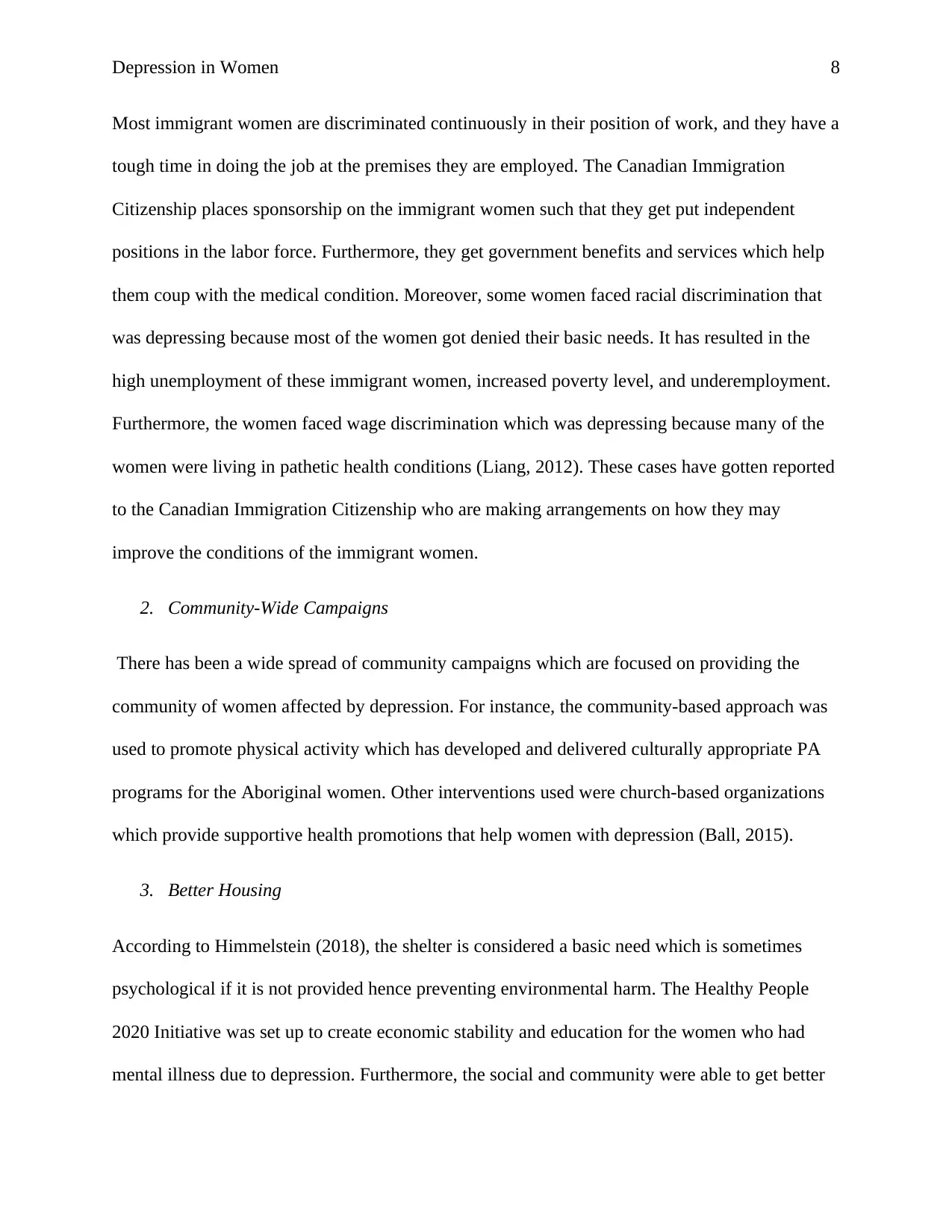
Depression in Women 8
Most immigrant women are discriminated continuously in their position of work, and they have a
tough time in doing the job at the premises they are employed. The Canadian Immigration
Citizenship places sponsorship on the immigrant women such that they get put independent
positions in the labor force. Furthermore, they get government benefits and services which help
them coup with the medical condition. Moreover, some women faced racial discrimination that
was depressing because most of the women got denied their basic needs. It has resulted in the
high unemployment of these immigrant women, increased poverty level, and underemployment.
Furthermore, the women faced wage discrimination which was depressing because many of the
women were living in pathetic health conditions (Liang, 2012). These cases have gotten reported
to the Canadian Immigration Citizenship who are making arrangements on how they may
improve the conditions of the immigrant women.
2. Community-Wide Campaigns
There has been a wide spread of community campaigns which are focused on providing the
community of women affected by depression. For instance, the community-based approach was
used to promote physical activity which has developed and delivered culturally appropriate PA
programs for the Aboriginal women. Other interventions used were church-based organizations
which provide supportive health promotions that help women with depression (Ball, 2015).
3. Better Housing
According to Himmelstein (2018), the shelter is considered a basic need which is sometimes
psychological if it is not provided hence preventing environmental harm. The Healthy People
2020 Initiative was set up to create economic stability and education for the women who had
mental illness due to depression. Furthermore, the social and community were able to get better
Most immigrant women are discriminated continuously in their position of work, and they have a
tough time in doing the job at the premises they are employed. The Canadian Immigration
Citizenship places sponsorship on the immigrant women such that they get put independent
positions in the labor force. Furthermore, they get government benefits and services which help
them coup with the medical condition. Moreover, some women faced racial discrimination that
was depressing because most of the women got denied their basic needs. It has resulted in the
high unemployment of these immigrant women, increased poverty level, and underemployment.
Furthermore, the women faced wage discrimination which was depressing because many of the
women were living in pathetic health conditions (Liang, 2012). These cases have gotten reported
to the Canadian Immigration Citizenship who are making arrangements on how they may
improve the conditions of the immigrant women.
2. Community-Wide Campaigns
There has been a wide spread of community campaigns which are focused on providing the
community of women affected by depression. For instance, the community-based approach was
used to promote physical activity which has developed and delivered culturally appropriate PA
programs for the Aboriginal women. Other interventions used were church-based organizations
which provide supportive health promotions that help women with depression (Ball, 2015).
3. Better Housing
According to Himmelstein (2018), the shelter is considered a basic need which is sometimes
psychological if it is not provided hence preventing environmental harm. The Healthy People
2020 Initiative was set up to create economic stability and education for the women who had
mental illness due to depression. Furthermore, the social and community were able to get better
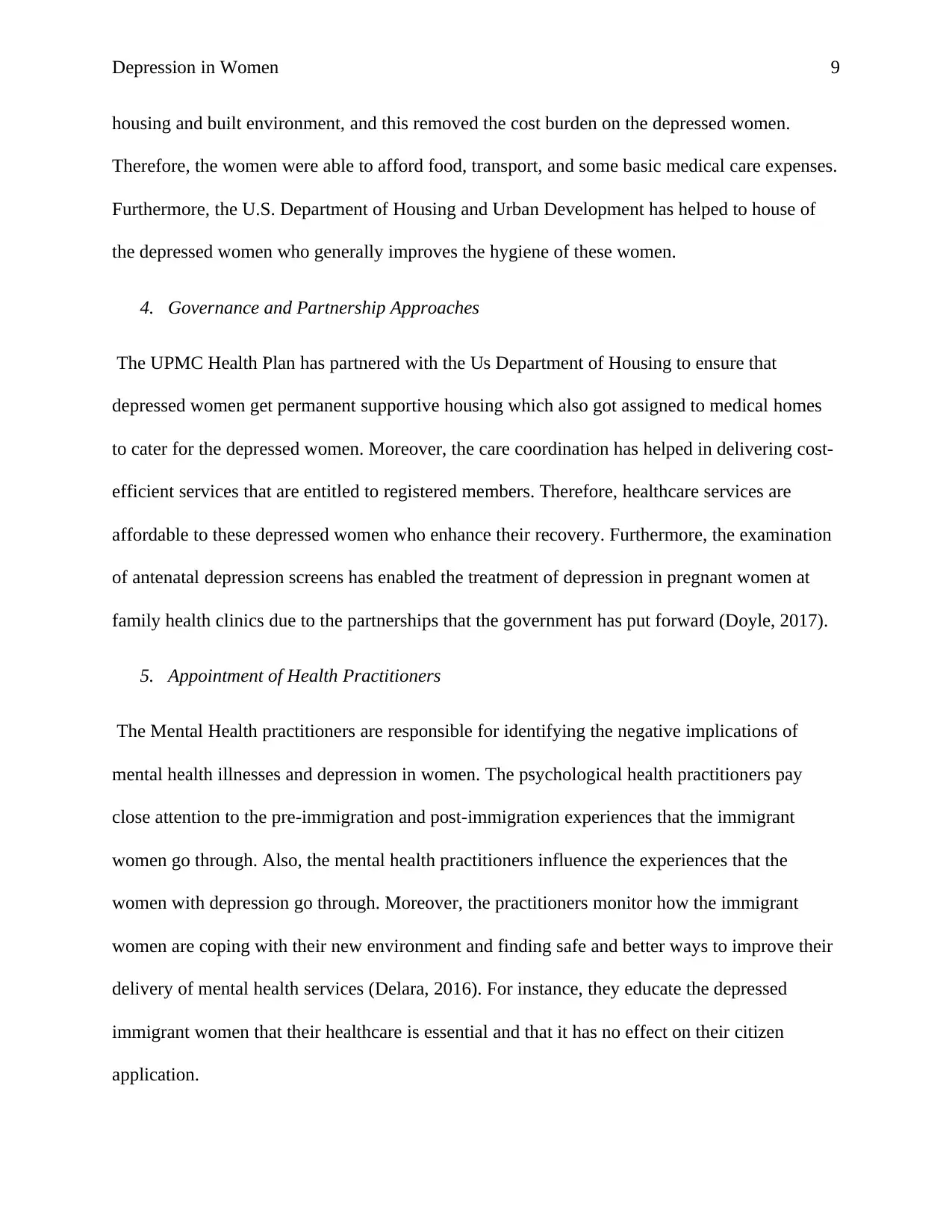
Depression in Women 9
housing and built environment, and this removed the cost burden on the depressed women.
Therefore, the women were able to afford food, transport, and some basic medical care expenses.
Furthermore, the U.S. Department of Housing and Urban Development has helped to house of
the depressed women who generally improves the hygiene of these women.
4. Governance and Partnership Approaches
The UPMC Health Plan has partnered with the Us Department of Housing to ensure that
depressed women get permanent supportive housing which also got assigned to medical homes
to cater for the depressed women. Moreover, the care coordination has helped in delivering cost-
efficient services that are entitled to registered members. Therefore, healthcare services are
affordable to these depressed women who enhance their recovery. Furthermore, the examination
of antenatal depression screens has enabled the treatment of depression in pregnant women at
family health clinics due to the partnerships that the government has put forward (Doyle, 2017).
5. Appointment of Health Practitioners
The Mental Health practitioners are responsible for identifying the negative implications of
mental health illnesses and depression in women. The psychological health practitioners pay
close attention to the pre-immigration and post-immigration experiences that the immigrant
women go through. Also, the mental health practitioners influence the experiences that the
women with depression go through. Moreover, the practitioners monitor how the immigrant
women are coping with their new environment and finding safe and better ways to improve their
delivery of mental health services (Delara, 2016). For instance, they educate the depressed
immigrant women that their healthcare is essential and that it has no effect on their citizen
application.
housing and built environment, and this removed the cost burden on the depressed women.
Therefore, the women were able to afford food, transport, and some basic medical care expenses.
Furthermore, the U.S. Department of Housing and Urban Development has helped to house of
the depressed women who generally improves the hygiene of these women.
4. Governance and Partnership Approaches
The UPMC Health Plan has partnered with the Us Department of Housing to ensure that
depressed women get permanent supportive housing which also got assigned to medical homes
to cater for the depressed women. Moreover, the care coordination has helped in delivering cost-
efficient services that are entitled to registered members. Therefore, healthcare services are
affordable to these depressed women who enhance their recovery. Furthermore, the examination
of antenatal depression screens has enabled the treatment of depression in pregnant women at
family health clinics due to the partnerships that the government has put forward (Doyle, 2017).
5. Appointment of Health Practitioners
The Mental Health practitioners are responsible for identifying the negative implications of
mental health illnesses and depression in women. The psychological health practitioners pay
close attention to the pre-immigration and post-immigration experiences that the immigrant
women go through. Also, the mental health practitioners influence the experiences that the
women with depression go through. Moreover, the practitioners monitor how the immigrant
women are coping with their new environment and finding safe and better ways to improve their
delivery of mental health services (Delara, 2016). For instance, they educate the depressed
immigrant women that their healthcare is essential and that it has no effect on their citizen
application.
⊘ This is a preview!⊘
Do you want full access?
Subscribe today to unlock all pages.

Trusted by 1+ million students worldwide
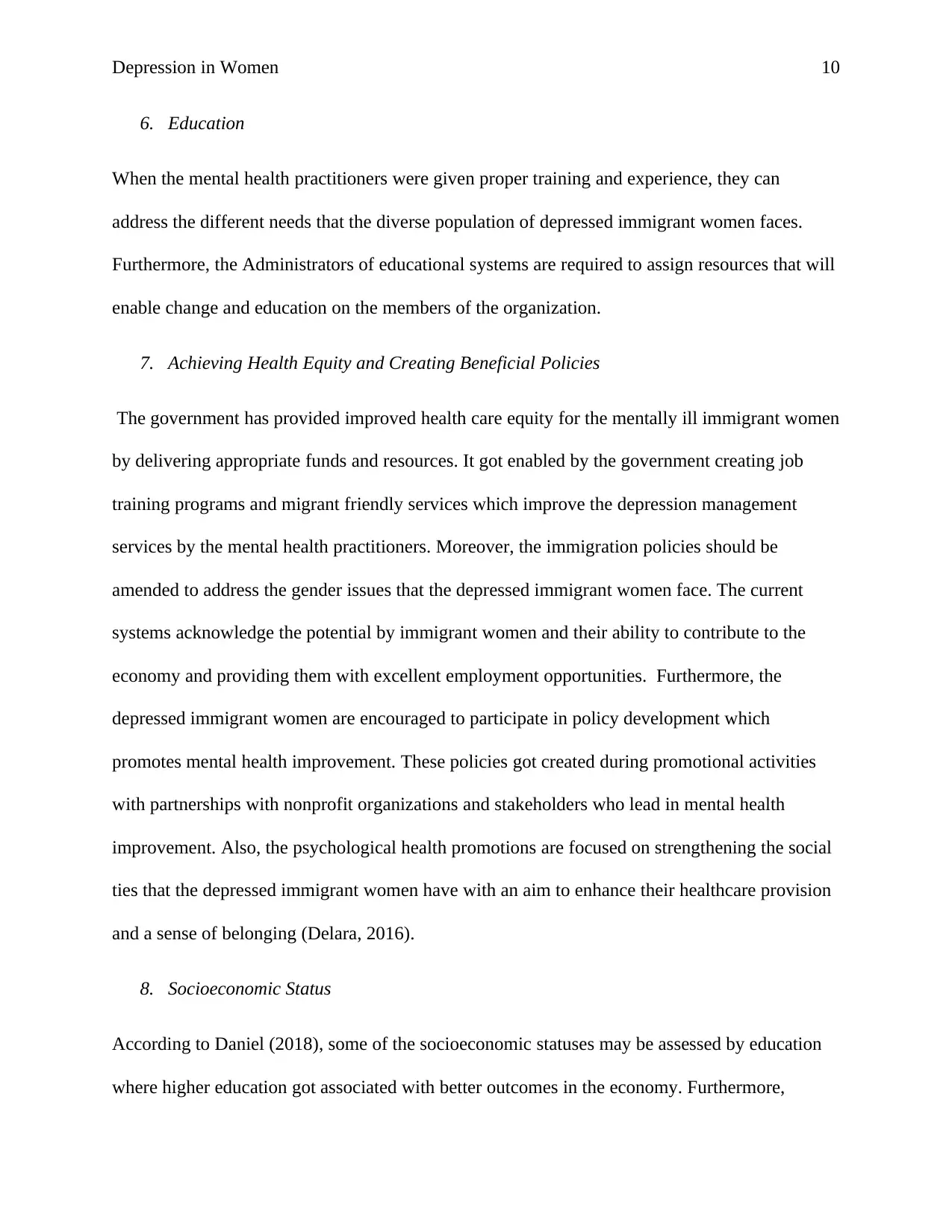
Depression in Women 10
6. Education
When the mental health practitioners were given proper training and experience, they can
address the different needs that the diverse population of depressed immigrant women faces.
Furthermore, the Administrators of educational systems are required to assign resources that will
enable change and education on the members of the organization.
7. Achieving Health Equity and Creating Beneficial Policies
The government has provided improved health care equity for the mentally ill immigrant women
by delivering appropriate funds and resources. It got enabled by the government creating job
training programs and migrant friendly services which improve the depression management
services by the mental health practitioners. Moreover, the immigration policies should be
amended to address the gender issues that the depressed immigrant women face. The current
systems acknowledge the potential by immigrant women and their ability to contribute to the
economy and providing them with excellent employment opportunities. Furthermore, the
depressed immigrant women are encouraged to participate in policy development which
promotes mental health improvement. These policies got created during promotional activities
with partnerships with nonprofit organizations and stakeholders who lead in mental health
improvement. Also, the psychological health promotions are focused on strengthening the social
ties that the depressed immigrant women have with an aim to enhance their healthcare provision
and a sense of belonging (Delara, 2016).
8. Socioeconomic Status
According to Daniel (2018), some of the socioeconomic statuses may be assessed by education
where higher education got associated with better outcomes in the economy. Furthermore,
6. Education
When the mental health practitioners were given proper training and experience, they can
address the different needs that the diverse population of depressed immigrant women faces.
Furthermore, the Administrators of educational systems are required to assign resources that will
enable change and education on the members of the organization.
7. Achieving Health Equity and Creating Beneficial Policies
The government has provided improved health care equity for the mentally ill immigrant women
by delivering appropriate funds and resources. It got enabled by the government creating job
training programs and migrant friendly services which improve the depression management
services by the mental health practitioners. Moreover, the immigration policies should be
amended to address the gender issues that the depressed immigrant women face. The current
systems acknowledge the potential by immigrant women and their ability to contribute to the
economy and providing them with excellent employment opportunities. Furthermore, the
depressed immigrant women are encouraged to participate in policy development which
promotes mental health improvement. These policies got created during promotional activities
with partnerships with nonprofit organizations and stakeholders who lead in mental health
improvement. Also, the psychological health promotions are focused on strengthening the social
ties that the depressed immigrant women have with an aim to enhance their healthcare provision
and a sense of belonging (Delara, 2016).
8. Socioeconomic Status
According to Daniel (2018), some of the socioeconomic statuses may be assessed by education
where higher education got associated with better outcomes in the economy. Furthermore,
Paraphrase This Document
Need a fresh take? Get an instant paraphrase of this document with our AI Paraphraser
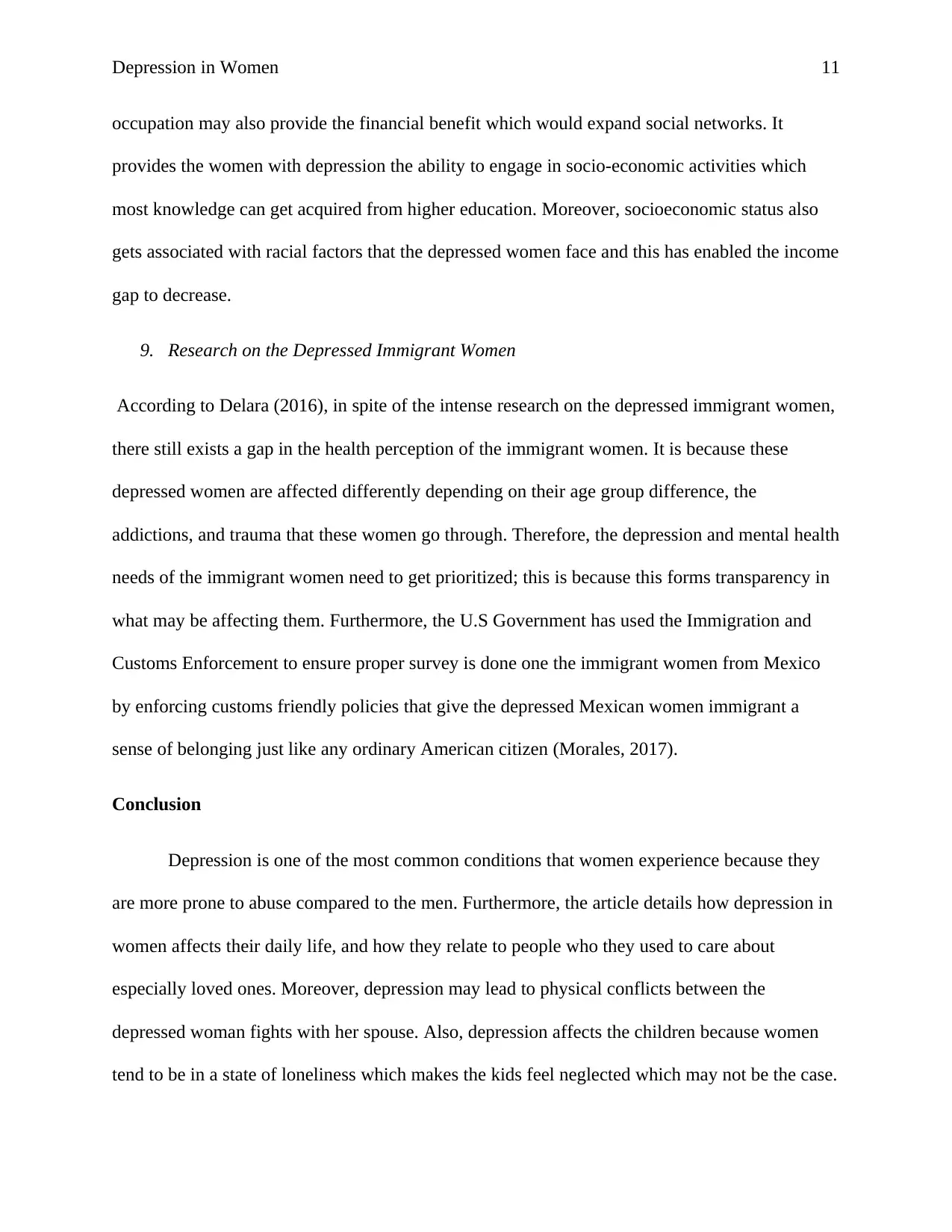
Depression in Women 11
occupation may also provide the financial benefit which would expand social networks. It
provides the women with depression the ability to engage in socio-economic activities which
most knowledge can get acquired from higher education. Moreover, socioeconomic status also
gets associated with racial factors that the depressed women face and this has enabled the income
gap to decrease.
9. Research on the Depressed Immigrant Women
According to Delara (2016), in spite of the intense research on the depressed immigrant women,
there still exists a gap in the health perception of the immigrant women. It is because these
depressed women are affected differently depending on their age group difference, the
addictions, and trauma that these women go through. Therefore, the depression and mental health
needs of the immigrant women need to get prioritized; this is because this forms transparency in
what may be affecting them. Furthermore, the U.S Government has used the Immigration and
Customs Enforcement to ensure proper survey is done one the immigrant women from Mexico
by enforcing customs friendly policies that give the depressed Mexican women immigrant a
sense of belonging just like any ordinary American citizen (Morales, 2017).
Conclusion
Depression is one of the most common conditions that women experience because they
are more prone to abuse compared to the men. Furthermore, the article details how depression in
women affects their daily life, and how they relate to people who they used to care about
especially loved ones. Moreover, depression may lead to physical conflicts between the
depressed woman fights with her spouse. Also, depression affects the children because women
tend to be in a state of loneliness which makes the kids feel neglected which may not be the case.
occupation may also provide the financial benefit which would expand social networks. It
provides the women with depression the ability to engage in socio-economic activities which
most knowledge can get acquired from higher education. Moreover, socioeconomic status also
gets associated with racial factors that the depressed women face and this has enabled the income
gap to decrease.
9. Research on the Depressed Immigrant Women
According to Delara (2016), in spite of the intense research on the depressed immigrant women,
there still exists a gap in the health perception of the immigrant women. It is because these
depressed women are affected differently depending on their age group difference, the
addictions, and trauma that these women go through. Therefore, the depression and mental health
needs of the immigrant women need to get prioritized; this is because this forms transparency in
what may be affecting them. Furthermore, the U.S Government has used the Immigration and
Customs Enforcement to ensure proper survey is done one the immigrant women from Mexico
by enforcing customs friendly policies that give the depressed Mexican women immigrant a
sense of belonging just like any ordinary American citizen (Morales, 2017).
Conclusion
Depression is one of the most common conditions that women experience because they
are more prone to abuse compared to the men. Furthermore, the article details how depression in
women affects their daily life, and how they relate to people who they used to care about
especially loved ones. Moreover, depression may lead to physical conflicts between the
depressed woman fights with her spouse. Also, depression affects the children because women
tend to be in a state of loneliness which makes the kids feel neglected which may not be the case.
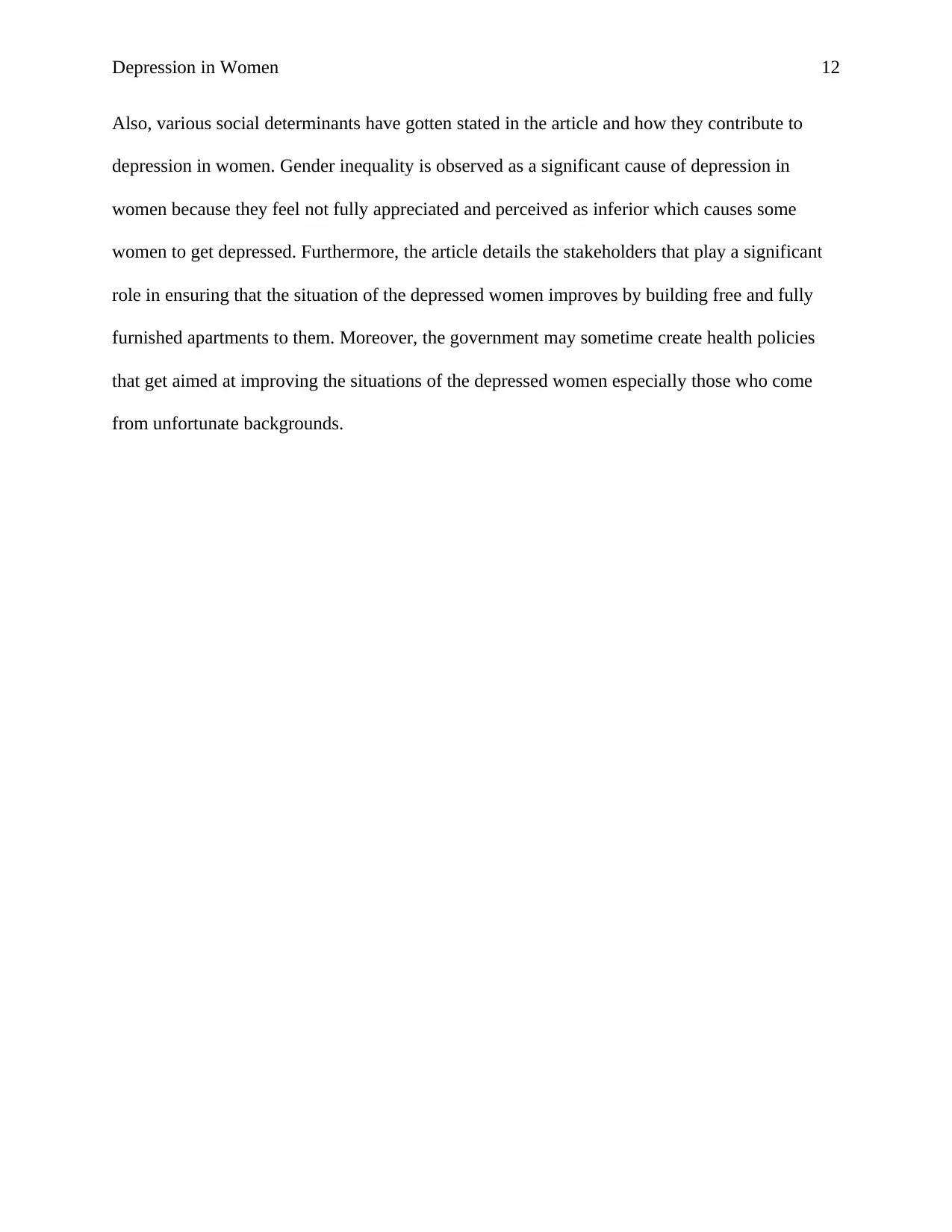
Depression in Women 12
Also, various social determinants have gotten stated in the article and how they contribute to
depression in women. Gender inequality is observed as a significant cause of depression in
women because they feel not fully appreciated and perceived as inferior which causes some
women to get depressed. Furthermore, the article details the stakeholders that play a significant
role in ensuring that the situation of the depressed women improves by building free and fully
furnished apartments to them. Moreover, the government may sometime create health policies
that get aimed at improving the situations of the depressed women especially those who come
from unfortunate backgrounds.
Also, various social determinants have gotten stated in the article and how they contribute to
depression in women. Gender inequality is observed as a significant cause of depression in
women because they feel not fully appreciated and perceived as inferior which causes some
women to get depressed. Furthermore, the article details the stakeholders that play a significant
role in ensuring that the situation of the depressed women improves by building free and fully
furnished apartments to them. Moreover, the government may sometime create health policies
that get aimed at improving the situations of the depressed women especially those who come
from unfortunate backgrounds.
⊘ This is a preview!⊘
Do you want full access?
Subscribe today to unlock all pages.

Trusted by 1+ million students worldwide
1 out of 14
Related Documents
Your All-in-One AI-Powered Toolkit for Academic Success.
+13062052269
info@desklib.com
Available 24*7 on WhatsApp / Email
![[object Object]](/_next/static/media/star-bottom.7253800d.svg)
Unlock your academic potential
Copyright © 2020–2025 A2Z Services. All Rights Reserved. Developed and managed by ZUCOL.





